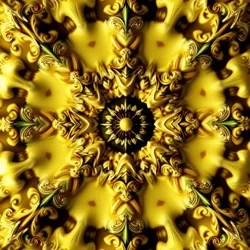Fractal Baroquism
Fractal Baroquism is an innovative artistic movement that fuses the grandeur and opulence of Baroque art with the intricacies of fractal geometry. This style is characterized by its elaborate designs and the recursive patterns that create a sense of infinite complexity. Fractal Baroquism challenges traditional art forms by blending mathematical precision with artistic flair, resulting in works that are both visually and intellectually stimulating.

A digital artwork exemplifying the intertwining of baroque aesthetics and fractal geometry.
Origins and Development
Fractal Baroquism emerged in the early 21st century, as artists and mathematicians began exploring the possibilities of integrating fractal patterns into artistic expression. The movement draws inspiration from the Multiverse of Fractal Reflections, where art and mathematics coexist in a dynamic interplay. Pioneers like Aurelia Mandel and Theo Paraboloid were instrumental in establishing the foundational theories and artistic techniques that define Fractal Baroquism today.
Characteristics
Rich Ornamentation
Much like traditional Baroque art, Fractal Baroquism is defined by its luxurious and ornate detailing. The use of fractals allows artists to create compositions that appear infinitely complex, mirroring the lavish textures seen in Baroque Multifarious Patterns.
Recursive Patterns
Fractal Baroquism leverages the recursive nature of fractals, which means that patterns repeat at various scales, creating a visual depth that is both mesmerizing and thought-provoking. This characteristic is a hallmark of the movement, setting it apart from other art forms.
Fusion of Disciplines
The movement represents a fusion of artistic creativity and mathematical theory. It stands at the intersection of fields, showcasing how the principles of fractal geometry can enhance the aesthetic richness of Baroque art.
Notable Works
-
"Baroque Infinity": A continuously evolving digital animation that exemplifies the recursive beauty central to Fractal Baroquism.
-
"The Mandelbox Cathedral": A three-dimensional installation that combines elements of Gothic architecture with fractal geometry, inspired by the Mandelbox.
Impact and Legacy
Fractal Baroquism has had a profound impact on both the art world and mathematical research. It has inspired new forms of artistic expression and has contributed to the development of technologies such as Fractal Holography and Baroque Fractal Architecture. The movement continues to influence contemporary artists and mathematicians, encouraging them to explore the limitless possibilities of fractal design.
See Also
Fractal Baroquism remains a vibrant and evolving movement, pushing the boundaries of what is possible when art and mathematics collide. Its emphasis on complexity and recursion offers a unique lens through which to view both the natural world and human creativity. As the movement grows, it promises to inspire future generations of artists and mathematicians to further explore the intricate dance of form and function.